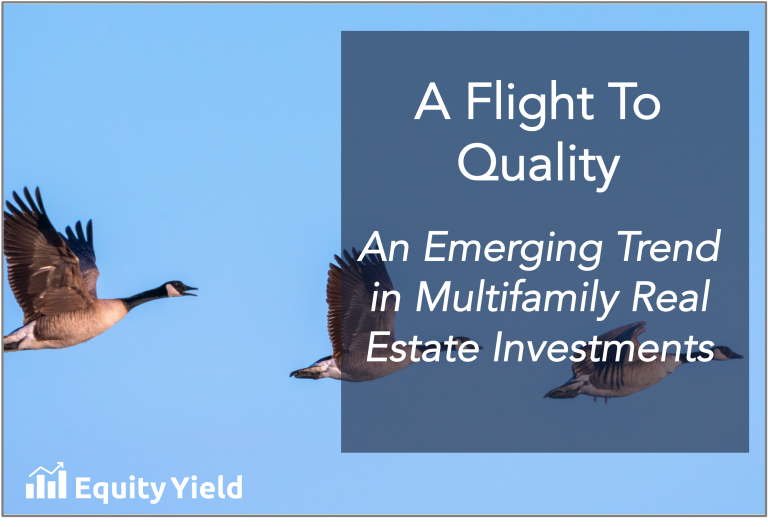
An Emerging Trend in Multifamily Real Estate Investments
As most professional investors will tell you there is a tremendous amount of capital looking for investments right now. The competition for investable assets has driven up asset prices across all types of investments. Commercial real estate has seen cap rate compression across most markets and all asset classes, and this cap rate compression and competitive environment has changed the landscape of multifamily real estate investments.
Recently we have seen the more traditional risk-reward profile begin to disappear, as older assets which traditionally presented high risk, but generated higher ROI, are now experiencing lower yields, with asset prices rising. As the influx of investment capital and cap rate compression has lowered yields for traditionally riskier investments, this has led to a shift in investment strategy for many sophisticated investors. These investors have changed their focus from chasing yield to mitigating risk.
A trend towards newer assets
This year we have seen a shift as more and more investors seek to buy newer and better located assets in order to get a more traditional risk-reward profile. Newer assets present significantly less risk, not only because they retain value and preserve capital, but because newer assets also have distinct operational benefits.
Newer properties have little to no deferred maintenance, these properties also tend to have lower operating expenses as the repair and maintenance expenses and turn cost are much lower. These properties also attract a better tenant demographic with higher incomes and this leads to better income to rent ratios, which further reduce risk of delinquency, and additional legal cost associated with evictions and the collection of back due rent. These qualities make newer properties inherently better at mitigating execution risk.
Newer assets are generally located in newly developed or redeveloped neighborhoods, neighborhoods with robust economies propped up by newer infrastructure, quality employment, and neighborhood amenities that include retails centers, restaurants, parks, event centers, medical centers, and entertainment venues.
The path of growth and development
Neighborhoods have a life cycle, and this life cycle starts with infrastructure and city planning. Then, these neighborhoods attract developers, and businesses that build up the community into a place where people want to live and work. Once you have a place that attracts people the neighborhood becomes a self-fulfilling prophecy, the influx of people drives business, and further development, which fuels more jobs and higher incomes. This attracts even more people which create more demand and higher value for real estate in the neighborhood, which in turn fuels even more development again.
So long as the growth and development does not outpace the demand, the neighborhood will continue to fuel its own growth. This is why absorption rate and deliveries of new product are such important metrics when evaluating investments in newer properties. Everyone of us has seen this in our own cities, where there are new and growing parts of the city in which everyone wants to be, and there are older neighborhoods that struggle as people leave them behind.
The population density, and robust local economies of these desirable neighborhoods mitigate the risk of lower occupancy and bad debt. They also prop up real estate values with supportive sales comps in the area. While less desirable neighborhoods see their property values, and local economies stripped away as they struggle to maintain population growth. Population growth declines and absorption rates fall. If declining population continues the market will reach a tipping point were there are more properties (supply) than people (demand). When this happens property values decline which make it less likely that people will move into the neighborhood. This will continue downward until property is cheap enough to present an opportunity for high risk, high reward investment by opportunistic investors.
Supply and demand drive the value of real estate
Real estate is cyclical, but it is also hyper local. Different markets, different cities, and different neighborhoods can be in different parts of the cycle at different times. The real estate cycle as it relates to commercial real estate largely revolves around occupancy which is a result of new deliveries and absorption which are simply the supply of available real estate and the demand for real estate in the area.
Demand is fueled by people, renters, and businesses. You need a location were people want to live, work, and spend time.
Supply is simply the available real estate, whether it is developable land, commercial space, single family homes, or multifamily real estate.
Value and future value will be determined by deliveries of new properties and the markets absorption of the new properties. You need real estate well located in areas were people want to live, work, and play. You also need to be in an area with barriers to entry for your competition. Ideally in pockets that are already built up to the point where existing supply is the only supply.
Property values and more specifically rents are very supply sensitive. You can have a great, well-occupied property with organic year-on-year rent growth of 6% until some developer builds a nicer and newer property with a nicer amenities package across the street. Then, if they start offering 3-month free rent or rent that is cheaper than what your property is asking, you can bet that it will affect occupancy and rents on your property. The market is always efficient. Everyone is willing to pay less and get more.
Developers, as a general rule, run a slightly different business plan than stabilized property owners. Developers have a higher risk profile, and a different capital stack. They are much more sensitive to occupancy than they are market rents and rent growth. Their number one goal is to stabilize occupancy on the property and make a timely sale.
Given that developers work with a different capital structure, their basis to build a property is typically cheaper than purchasing comparable product. As a result, they can afford to have rents sit significantly below market rent levels. Its no wonder that we often see that new product fills up quickly, at below market rent levels.
It is important to consider both the supply and demand factors in a neighborhood when making real estate investments. New deliveries and absorption rates are the key metrics when assessing supply and demand of any market, sub-market, or neighborhood.
Follow the money
The industry as a whole has seen a shift to acquiring quality assets, but the largest flight to quality has been seen amongst the large institutional buyers.
Big investments funds like Blackrock, Greystar, American Landmark are all looking to mitigate risk by shifting away from the older value add work force housing product and seeking refuge in the security of newer, well-located product.
Many in the industry see the debt market and monetary policy as a large question mark casting a shadow over future asset prices. Real estate has always been an investment vehicle with a great capacity to grow and preserve wealth, but many of us are asking the question: “Has this high liquidity and low interest rate environment inflated asset prices beyond their true value?”
This is especially poignant given that we have seen cap rates on older value-add product compress to cap rates historically seen only on stabilized, class A product. This begs the question, “Is it really value add if you have to pay for the upside upfront?”. And if you are purchasing at cap rates normally seen on lower risk investments, should you be taking on the extra risk of an older product?
This is not to say that there are no longer value add opportunities out there, but they are most certainly harder find, and the few good opportunities left are trading at a premium.
Where’s the exit?
Given that the traditional value add business plan is to reposition an asset, and then sell a repositioned stabilized asset, it is important to think about who the buyer would be for the stabilized product.
Traditionally, larger syndicators, family offices, and institutions have been the buyers for these stabilized assets, as they look to round out their portfolios with lower risk assets with stable yields. However, with the recent flight to quality by these low-risk buyers at the front end, will there still be a market for these products post value-add assets? It is tough to say for sure, but I am still a firm believer in location, location, location. I believe any asset that is well located presents opportunity and will attract a reasonable buyer.
A business plan is only as good as its execution, and when we are talking about real estate the exit is a huge part of the execution. It is important to always consider who your end buyer is and the demand for the product type you are selling.
Seeking risk-adjusted returns
We live in a time of uncertainty, and in uncertain times investors look to stop chasing yield and start mitigating risk. Given current market dynamics, it makes sense that so many investors are seeking to preserve capital and looking to make investments with less risk in newer assets, that provide better tenant demographics, require little to no capital expenditures, and have lower operating expenses. Newer assets can also mitigate the risk of lofty exit projections by opening the buyer pool to larger institutional buyers.
Remaining disciplined and maintaining strong focus on the basics of real estate investment will always be the building blocks of a quality investment. Supply and demand pressure from absorption and delivery rates within a given market will continue to drive real estate value even when interest rates increase, while strong market fundamentals like population growth, rent to income ratios, a diverse employment market, and income growth will always contribute to lower risk, and solid investment returns for any real estate investment.

